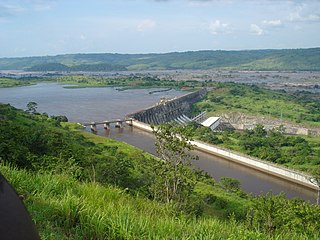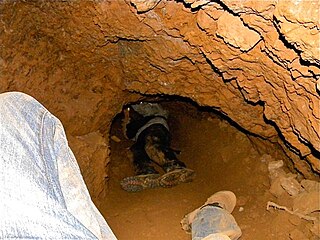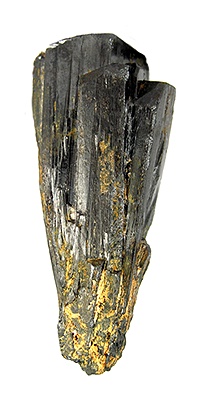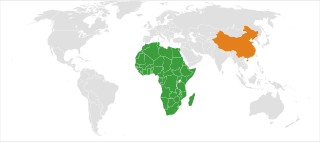
The Democratic Republic of the Congo (DRC) is the largest country of sub-Saharan Africa, occupying some 2,344,858 square kilometres (905,355 sq mi). Most of the country lies within the vast hollow of the Congo River basin. The vast, low-lying central area is a plateau-shaped basin sloping toward the west, covered by tropical rainforest and criss-crossed by rivers. The forest center is surrounded by mountainous terraces in the west, plateaus merging into savannas in the south and southwest. Dense grasslands extend beyond the Congo River in the north. High mountains of the Ruwenzori Range are found on the eastern borders with Rwanda and Uganda.

The economy of the Democratic Republic of the Congo has declined drastically around the 1980s, despite being home to vast potential in natural resources and mineral wealth; their gross domestic product is $69.474 billion as of 2023. During the last five reported years the exports of Democratic Republic of the Congo have changed by $15.2B from $13.3B in 2017 to $28.5B in 2022.

The economy of Equatorial Guinea has traditionally been dependent on commodities such as cocoa and coffee, but is now heavily dependent on petroleum due to the discovery and exploitation of significant oil reserves in the 1980s. In 2017, it graduated from "Least Developed Country" status, one of six Sub-Saharan African nations that managed to do so.

The Democratic Republic of the Congo, also known as Congo-Kinshasa, Congo-Zaire, Congo DR, DR Congo, DRC, or simply either Congo or the Congo, is a country in Central Africa. By land area, the DRC is the second-largest country in Africa and the 11th-largest in the world. With a population of around 105 million, the Democratic Republic of the Congo is the most populous Francophone country in the world, and the fourth-largest in Africa. The national capital and largest city is Kinshasa, which is also the economic center. The country is bordered by the Republic of the Congo, Central African Republic, South Sudan, Uganda, Rwanda, Burundi, Tanzania, Zambia, Angola, the Cabinda exclave of Angola, and the South Atlantic Ocean.

Coltan is a dull black metallic ore from which the elements niobium and tantalum are extracted. The niobium-dominant mineral in coltan is columbite, and the tantalum-dominant mineral is tantalite.

Global Witness is an international NGO established in 1993 that works to break the links between natural resource exploitation, conflict, poverty, corruption, and human rights abuses worldwide. The organisation has offices in London and Washington, D.C.

Eurasian Natural Resources Corporation PLC (ENRC) was a public, Kazakhstan/Central African-focused, multinational leading diversified natural resources company headquartered in London, United Kingdom. It had activities in integrated mining, processing, energy, logistics and marketing.

The mining industry of the Democratic Republic of the Congo produces copper, diamonds, tantalum, tin, gold, and more than 63% of global cobalt production. Minerals and petroleum are central to the DRC's economy, making up more than 95% of the value of its exports. According to a 2011 report the total value of the major mineral reserves in the DRC amounted to a total of over 300 billion US dollars at the time. The mining industry in the DRC mainly consists of private, large industrial mines, semi-industrial, and artisanal mines. While private sectors take on large operations, they rely heavily on artisanal mining for extraction of resources. These industries along with non-for-profit organizations are continuously changing their guidelines as the DRC becomes more and more desirable for their valuable minerals. Mining in the DRC took place beginning in the 14th century and is still very present today, with mass scale lootings halting many major projects. The main countries involved in the mining operations in the DRC are Canada and China along with 25 other international mines active in the area. While technological companies strive for sustainable production and consumption of their products using cobalt, this is often achieved by the work of artisanal mining in hazardous and unjust working conditions. The process of mining and extraction in any area has negative impacts on the environment and those living in it, however, the DRC has faced many acts of environmental injustice including child labor under fatal conditions, exploitation of laborers, and displacement.

The eastern Democratic Republic of the Congo (DRC) has a history of conflict, where various armies, rebel groups, and outside actors have profited from mining while contributing to violence and exploitation during wars in the region. The four main end products of mining in the eastern DRC are tin, tungsten, tantalum, and gold, which are extracted and passed through a variety of intermediaries before being sold to international markets. These four products, are essential in the manufacture of a variety of devices, including consumer electronics such as smartphones, tablets, and computers.
Despite being a mineral rich country, Cameroon has only recently begun to investigate mining on an industrial scale. Strong metal and industrial mineral prices since 2003 have encouraged companies to develop mines here. The terrain mainly consists of granite-rich ground with areas of ultramafic rocks that are sources of cobalt and nickel. There are also deposits of bauxite, gold, iron ore, nepheline syenite, and rutile. Alluvial gold is mainly mined by artisanal miners.
The second-largest mineral industry in the world is the mineral industry of Africa, which implies large quantities of resources due to Africa being the second largest continent, with 30.37 million square kilometres of land.With a population of 1.4 billion living there, mineral exploration and production constitute significant parts of their economies for many African countries and remain keys to economic growth. Africa is richly endowed with mineral reserves and ranks first in quantity of world reserves for bauxite, cobalt, industrial diamond, phosphate rock, platinum-group metals (PGM), vermiculite, and zirconium.

The Democratic Republic of the Congo was a net energy exporter in 2008. Most energy was consumed domestically in 2008. According to the IEA statistics the energy export was in 2008 small and less than from the Republic of Congo. 2010 population figures were 3.8 million for the RC compared to CDR 67.8 Million.

Artisanal and small-scale mining (ASM) is a blanket term for a type of subsistence mining involving a miner who may or may not be officially employed by a mining company but works independently, mining minerals using their own resources, usually by hand.
Copper mining in the Democratic Republic of the Congo mainly takes place in the Copper Belt of the southern Katanga Province of the Democratic Republic of the Congo.

Dan Gertler is an Israeli billionaire businessman in natural resources and the founder and president of the DGI group of companies. He has diamond and copper mining interests in the Democratic Republic of the Congo (DRC), and has invested in iron ore, gold, cobalt, oil, agriculture, and banking. He may also hold citizenship of that country. As of 2022 his fortune was estimated at $1.2 billion by Forbes.

Coltan is the colloquial name for the mineral columbite-tantalum ("col-tan"). In the early 21st century coltan mining is associated with human rights violations such as child labour, systematic exploitation of the population by governments or militant groups, exposure to toxic chemicals and other hazards as a result of lax environmental protection, and general safety laws and regulations.

Economic relations between China and Africa, one part of more general Africa–China relations, began in the 7th century and continue through the present day. Currently, China seeks resources for its growing consumption, and African countries seek funds to develop their infrastructure.

Oil and gas dominate the extraction industries of the Republic of the Congo, also referred to as Congo-Brazzaville. The petroleum industry accounted for 89% of the country’s exports in 2010. Among African crude oil producers in 2010, The Congo ranked seventh. Nearly all of the country's hydrocarbons were produced off-shore. The minerals sector is administered by the Department of Mines and Geology. Presently no major mining activities are underway, although there are some small-scale domestic operations. However, the country does have numerous large-scale undeveloped resources. The country has recently attracted a strong influx of international companies seeking to tap into the vast mineral wealth.
Oil and Gas dominate the resource sector of the Republic of the Congo, also referred to as Congo-Brazzaville, with the petroleum industry accounting for 89% of the country's exports in 2010. As of June 22, 2018, is a full member of the Organization of the Petroleum Exporting Countries (OPEC), and among African crude oil producers in 2022, The Congo ranked sixth. Nearly all of the country's hydrocarbons were produced off-shore.

The geology of the Democratic Republic of the Congo is extremely old, on the order of several billion years for many rocks. The country spans the Congo Craton: a stable section of ancient continental crust, deformed and influenced by several different mountain building orogeny events, sedimentation, volcanism and the geologically recent effects of the East African Rift System in the east. The country's complicated tectonic past have yielded large deposits of gold, diamonds, coltan and other valuable minerals.















